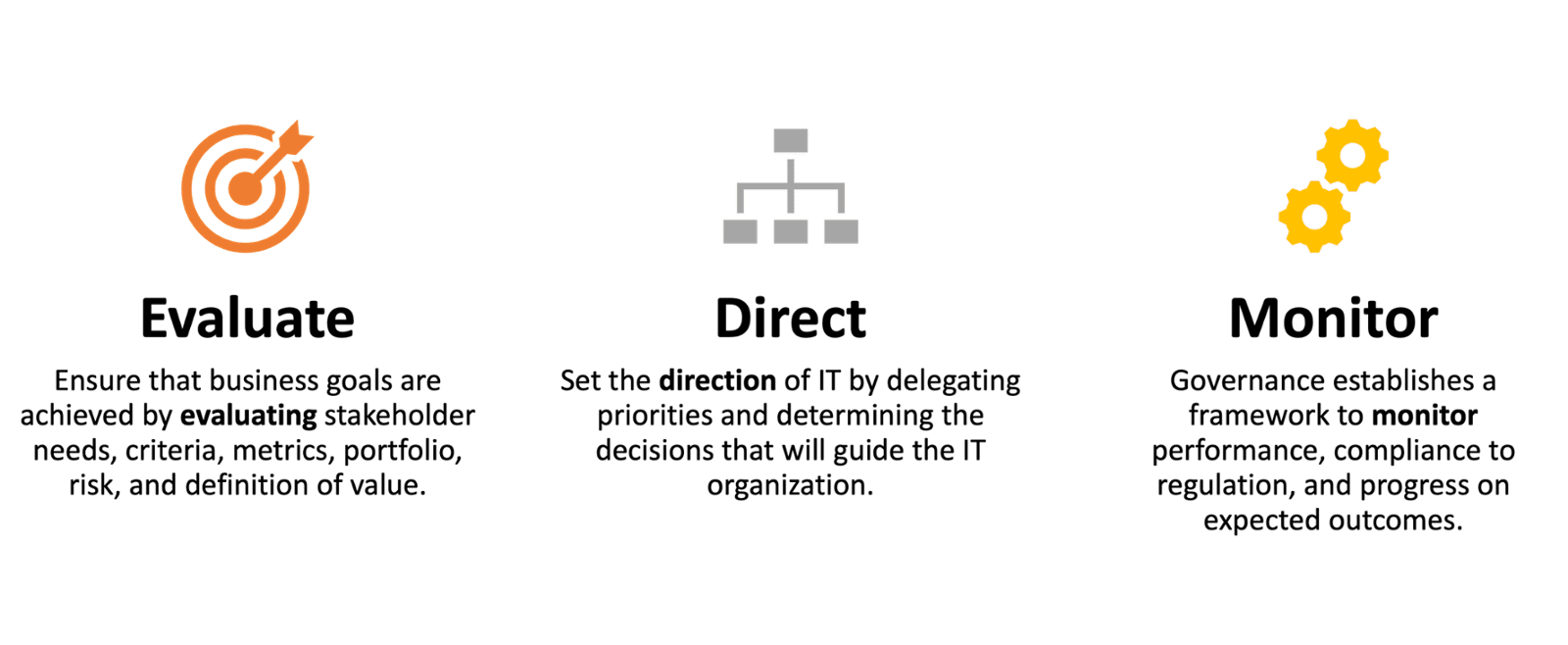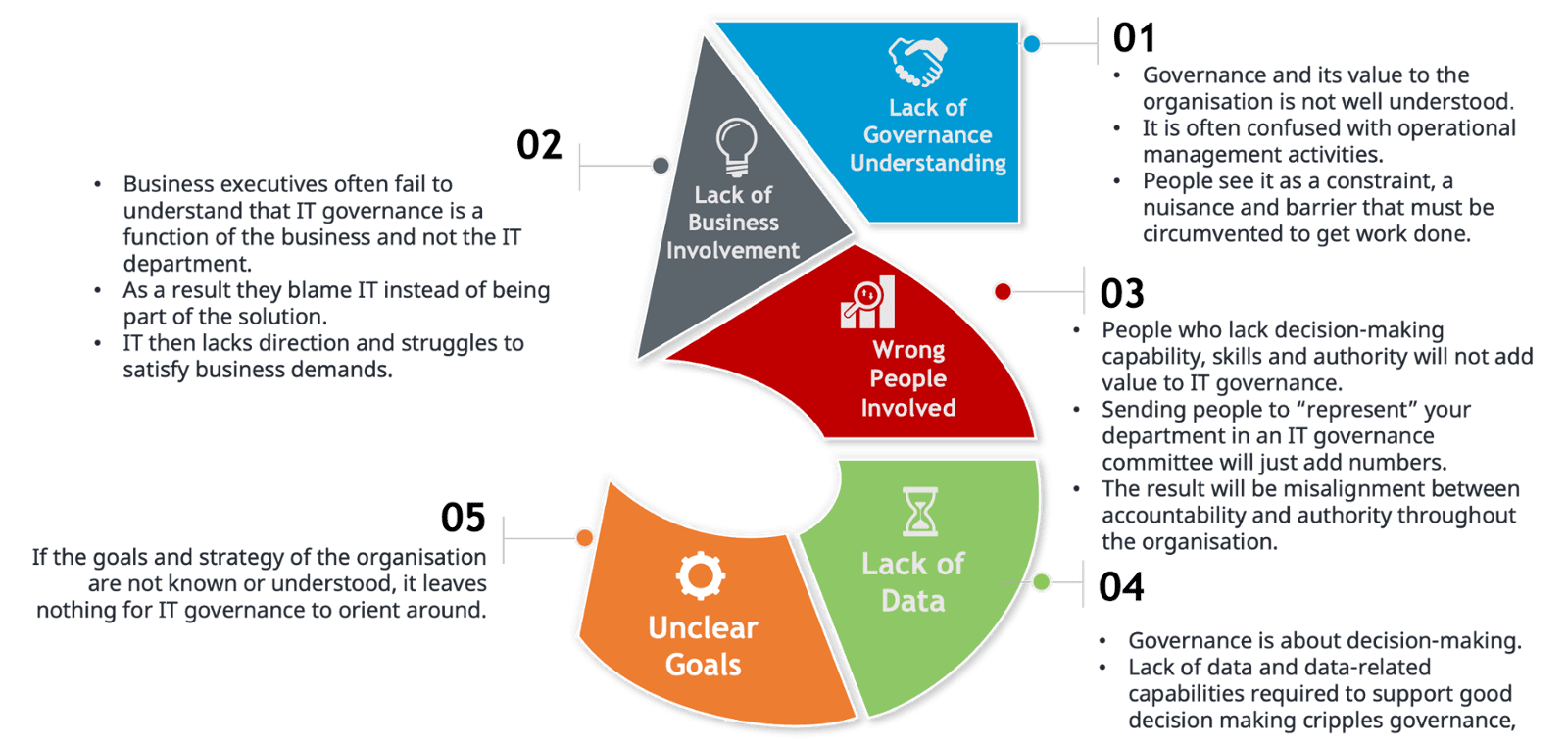A research conducted by Info-Tech Research Group discovered that the majority of organisations and their key stakeholders experience highly visible gaps in the alignment of IT investments and organisational goals. In particular, the study found that:
- 57% of CXOs identify a major gap in IT’s ability to support business goals.
- 84% of CXOs often perceive that IT is investing in areas that do not support the business.
- 88% of CIOs believe that their governance is not effective.

- Management is responsible for executing on, operating, and monitoring activities as determined by IT governance.
- Management makes decisions for implementing based on governance direction. Governance on the other hand aligns IT with the organisation's mission and vision.
Now that we have established a common understanding of the concept of IT governance, let's delve into how it can be used to drive business results.

How Does IT Governance Drive Business Results?
We have just established that one of the outcomes of corporate governance (of which IT governance is a subset) is effective leadership, which implies driving the organisation to achieve its strategic objectives and positive outcomes, i.e., to produce business results. For a long time organisations have struggled to hire IT leaders who would help the organisation use technology to drive business results.
Not many have had success in this regard, but those who did reaped the rewards and their companies became leaders in their respective industries. Examples of these companies in South Africa include First National Bank and the South African Revenue Service. The former pioneered online banking and received accolades worldwide, while the latter increased revenue collection for the country while making it easy for tax payers to submit tax returns through online submissions.
It is interesting to note that the driver of the online project at FNB was not the CIO but a business executive, while at SARS, although he was referred to as the CIO, his portfolio was more than IT and had the CIO reporting to him. This is testimony that business involvement at the highest level is an important success factor to drive business results through IT. Such involvement ensures that decisions about IT are made at the right level to drive technology in the right direction. This is the essence of IT governance. It provides an enabling framework for decision-making context and accountabilities for related processes. It is a means of ensuring business-IT collaboration, leading to increased consistency and transparency in decision making and prioritisation of initiatives.
The answer to the question of how IT governance drives business results lies in the collaborative roles of governance and management of IT. The adjacent "governance and management roles" diagram shows how the governance and management roles interact to meet business needs. The emphasis here is that both roles must pull together to achieve a common goal. This is achieved when IT governance is embedded in corporate governance.
IT governance sets the direction on the business priorities for IT management to focus on. It is important for IT governance to also set performance measurements to enable clarity on expectations and common understanding of success. IT management should then develop plans to enable the achievement of specific business goals linked to the set priorities. From the plans new and/or enhanced IT-enabled business capabilities will be built. These capabilities will be implemented through projects and ran as part of enhanced operations. IT management should monitor the performance of these new capabilities in line with the defined expectations and compile reports for IT governance.
IT governance will review the management reports in line with the set performance metrics and evaluate according to the business priorities. Upon evaluation, IT governance must give new direction and pledge support to IT management by providing required resources, be it financial, enabling policy or structural changes, etc.
For the process defined above to succeed an organisation needs to properly design its IT governance framework. The right committees must be set sup and given adequate mandate and authority. Each committee needs to know the decisions its can make and the input or information needed to make those decisions. The skill profiles and roles of the individuals comprising each committee must be carefully selected to ensure the effectiveness of the committee. It is important that when authority is delegated to a committee or individual, they are given space to exercise that authority while being held accountable for decisions taken.

- The 5 key Outcomes of IT governance
The outcomes of IT governance are premised on the five IT governance domains as defined by the IT Governance Institute some years back and which are still relevant today. These domains help IT governance to drive business results. The adjacent diagram represents the five domains of IT governance, namely, Strategic Alignment, Value Delivery, Risk Management, Resource Management and Performance Management. Here's the description of the outcomes from each domain:
Strategic Alignment
The key outcome of the strategic alignment domain is to ensure that technology investments and portfolios are aligned with the organisation's strategic objectives. The strategic objectives carry the information about the expected business results. It is therefore critical for IT to make investments that are geared towards obtaining returns that depict business results. Many IT and business leaders emphasise the importance of keeping abreast with technology trends. Although this is a necessity, but the point to be made is that it is more important to align with business objectives as you follow the trends. The IT portfolios - resources, policies and operating model, must be organised to achieve the organisation's strategic objectives.
It is the responsibility of IT governance to evaluate and approve IT strategies that are properly aligned to business goals and to ensure that the configuration of the IT portfolio and environment is also appropriately aligned.
Value Delivery
IT governance needs to make sure that IT investments and initiatives deliver the expected benefits. Before any major project or initiative is approved, clear business benefits must be stated and these must align with the organisation's strategic objectives. When benefits are clear approval will be simple and straightforward. The tendency to approve projects based on who shouts the loudest will be avoided and project success will be easily measured.
Risk Optimisation
The proper identification of IT risks is the responsibility of IT management. Risks involve both threats to the achievement of goals and opportunities that might be missed. It is therefore critical for risks to be properly identified so that the right mitigation actions can be taken to eliminate, avoid or reduce the impact of the risks. Equally important to risk management is the setting of risk tolerance levels, which is the responsibility of IT governance. Risk tolerance guides IT management on the choice of risk mitigation strategies and the balancing of effort against expected gains. As the African idiom goes "Don't use an assegai to kill an ant."
Resource Optimisation
Resources, including people, finances and tools, are key to the achievement of business results. Governance has the responsibility to ensure that resources are appropriately allocated across the organisation to realise optimal organisational benefit. This means that, among others, duplication must be avoided, people must possess the right skills, finances must be managed with utmost prudence. IT governance must determine the success metrics to measure performance in this area and receive and evaluate reports.
The focus for IT governance in this area is to ensure that performance of technology investments is monitored and used to determine future courses of action and to confirm achievement of success. This domain cuts across the rest of the other domains. Its purpose is to make sure that metrics are properly defined for each initiative. As the popular saying by Peter Drucker, goes "What gets measured gets managed." However, as we engage in the effort of measuring performance we are constantly reminded by wise words of Albeit Einstein that:

Common Causes of IT Governance Failure
IT governance, whether formalised or not, is always present in every organisation. This is so because decisions about IT are always taken, whether it's bad decisions or not.
By governance failure we mean the inability of an organisation to direct IT towards enabling business results. Here is a list of the most common causes of IT governance failure:

IT Governance Key Success Factors
Here are things that organisations should do to ensure IT governance success. Organisations who implemented these proven practices have achieved phenomenal success.
- Embed IT Governance into Corporate Governance - this is critical for IT and business alignment.
- Separate governance and management roles - eliminates confusion and enhance collaboration.
- Involve relevant business leaders, who will be impacted by IT outcomes, to take on governing responsibility of IT.
- Measure performance to ensure continuous improvement.
- Design a Right-size IT Governance Framework - consider the size and context of the organisation and structure IT governance to avoid stifling performance.






